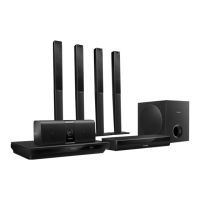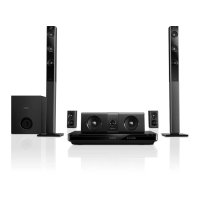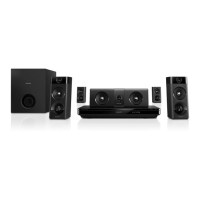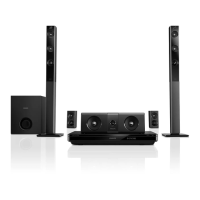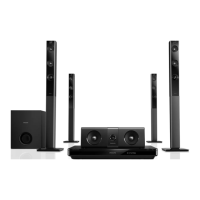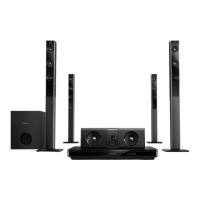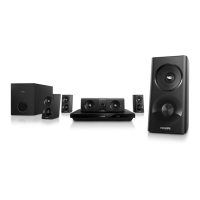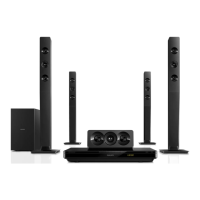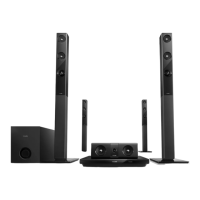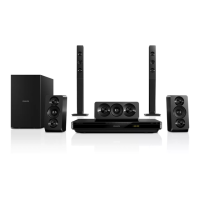Do you have a question about the Philips HTB5520 and is the answer not in the manual?
Safety warnings including electric shock, fire, injury, overheating, contamination, and battery risks.
Guidance on product recycling and proper disposal to prevent environmental harm.
Health precautions and recommendations for 3D viewing, especially for photosensitive individuals.
Instructions for maintaining the product, including disc handling and cleaning.
Description and function of the main unit's buttons and features.
Identification and function of buttons on the remote control.
Overview of front and rear connectors for audio, video, and power.
Details on the wireless box, its connections, and indicator light.
Guidelines for connecting speakers and optimizing surround sound placement.
Step-by-step instructions for wirelessly pairing rear speakers with the main unit.
Instructions for connecting the home theater to a TV via HDMI (ARC and standard).
Methods to connect audio from TVs and other devices using optical, coaxial, or analog cables.
Manual speaker setup to customize surround sound experience.
Configuration and control of EasyLink for integrated device management.
Troubleshooting audio output and mapping audio inputs.
Guidance on connecting to wired and wireless networks for enhanced features.
Steps to connect the home theater to a network using a LAN cable.
Steps to connect the home theater to a wireless network using Wi-Fi.
Naming the home theater for easy identification on the network.
How to navigate and use the main home menu for device access and settings.
Information on auto play, disc types, and playback controls.
Connecting Bluetooth devices for audio streaming and managing connections.
Pairing Bluetooth devices using NFC technology for simplified connection.
Playing picture, audio, and video files; selecting subtitle languages.
Adjusting audio, video, and picture settings for enhanced media playback.
Listening to FM radio and connecting external audio devices.
Accessing internet applications, browsing websites, and renting online videos.
Streaming audio/video content wirelessly from Miracast-certified devices.
Accessing and playing media files from a PC over the home network.
Playing karaoke discs and adjusting microphone settings.
Adjusting sound modes, surround sound, equalizer, and auto volume.
Configuring menu, audio, and subtitle languages for discs.
Adjusting picture format, resolution, deep color, and 3D video settings.
Configuring night mode and other audio playback preferences.
Setting up parental controls and restricting disc access based on age ratings.
Adjusting auto subtitle shift, display panel brightness, and VCD/SVCD playback.
Configuring screen saver, auto standby, and sleep timer options.
Adjusting speaker setup, including enhanced audio and karaoke settings.
Resetting the home theater to its factory default configurations.
How to verify the current software version installed on the home theater.
Step-by-step guide for updating the home theater software using a USB flash drive.
Instructions for updating software wirelessly through a network connection.
Information on supported DVD and Blu-ray region codes for different countries.
Lists supported audio, video, picture, and file formats.
Technical details for Amplifier, Video, Audio, Radio, USB, Main Unit, Subwoofer, and Speakers.
Details on wireless box, remote control batteries, laser, and Wi-Fi/Bluetooth standards.
Solutions for problems with the home theater's main unit buttons.
Troubleshooting steps for no picture or incorrect display on the TV.
Solutions for discs not playing, including DivX files and subtitle display.
Troubleshooting steps for no sound, distorted sound, or audio/video sync problems.
Resolving problems with Bluetooth, NFC, and wireless network connections.
Troubleshooting Miracast streaming and online video download problems.
Legal notices regarding copyright protection technologies and trademarks.
Information on open source software used and end user license terms for RMVB.
A comprehensive list of language codes used within the system.
Safety warnings including electric shock, fire, injury, overheating, contamination, and battery risks.
Guidance on product recycling and proper disposal to prevent environmental harm.
Health precautions and recommendations for 3D viewing, especially for photosensitive individuals.
Instructions for maintaining the product, including disc handling and cleaning.
Description and function of the main unit's buttons and features.
Identification and function of buttons on the remote control.
Overview of front and rear connectors for audio, video, and power.
Details on the wireless box, its connections, and indicator light.
Guidelines for connecting speakers and optimizing surround sound placement.
Step-by-step instructions for wirelessly pairing rear speakers with the main unit.
Instructions for connecting the home theater to a TV via HDMI (ARC and standard).
Methods to connect audio from TVs and other devices using optical, coaxial, or analog cables.
Manual speaker setup to customize surround sound experience.
Configuration and control of EasyLink for integrated device management.
Troubleshooting audio output and mapping audio inputs.
Guidance on connecting to wired and wireless networks for enhanced features.
Steps to connect the home theater to a network using a LAN cable.
Steps to connect the home theater to a wireless network using Wi-Fi.
Naming the home theater for easy identification on the network.
How to navigate and use the main home menu for device access and settings.
Information on auto play, disc types, and playback controls.
Connecting Bluetooth devices for audio streaming and managing connections.
Pairing Bluetooth devices using NFC technology for simplified connection.
Playing picture, audio, and video files; selecting subtitle languages.
Adjusting audio, video, and picture settings for enhanced media playback.
Listening to FM radio and connecting external audio devices.
Accessing internet applications, browsing websites, and renting online videos.
Streaming audio/video content wirelessly from Miracast-certified devices.
Accessing and playing media files from a PC over the home network.
Playing karaoke discs and adjusting microphone settings.
Adjusting sound modes, surround sound, equalizer, and auto volume.
Configuring menu, audio, and subtitle languages for discs.
Adjusting picture format, resolution, deep color, and 3D video settings.
Configuring night mode and other audio playback preferences.
Setting up parental controls and restricting disc access based on age ratings.
Adjusting auto subtitle shift, display panel brightness, and VCD/SVCD playback.
Configuring screen saver, auto standby, and sleep timer options.
Adjusting speaker setup, including enhanced audio and karaoke settings.
Resetting the home theater to its factory default configurations.
How to verify the current software version installed on the home theater.
Step-by-step guide for updating the home theater software using a USB flash drive.
Instructions for updating software wirelessly through a network connection.
Information on supported DVD and Blu-ray region codes for different countries.
Lists supported audio, video, picture, and file formats.
Technical details for Amplifier, Video, Audio, Radio, USB, Main Unit, Subwoofer, and Speakers.
Details on wireless box, remote control batteries, laser, and Wi-Fi/Bluetooth standards.
Solutions for problems with the home theater's main unit buttons.
Troubleshooting steps for no picture or incorrect display on the TV.
Solutions for discs not playing, including DivX files and subtitle display.
Troubleshooting steps for no sound, distorted sound, or audio/video sync problems.
Resolving problems with Bluetooth, NFC, and wireless network connections.
Troubleshooting Miracast streaming and online video download problems.
Legal notices regarding copyright protection technologies and trademarks.
Information on open source software used and end user license terms for RMVB.
A comprehensive list of language codes used within the system.
| Wireless satellite speakers | Yes |
|---|---|
| Number of satellite speakers | 4 |
| Satellite speakers RMS power | 166 W |
| Satellite speaker frequency range | 150 - 20000 Hz |
| Subwoofer type | Passive subwoofer |
| Subwoofer frequency range | 20 - 150 Hz |
| Subwoofer driver diameter (imperial) | 8 \ |
| Supported radio bands | FM |
| AC input voltage | 110-240 V |
| AC input frequency | 50 - 60 Hz |
| Supported batteries | 2 |
| Power consumption (standby) | 0.5 W |
| Power consumption (typical) | 160 W |
| Package weight | 13200 g |
| MP3 bit rates | 32 - 320 Kbit/s |
| Audio decoders | DTS Digital Plus, DTS Digital Surround, DTS-HD Master Audio, Dolby Digital 5.1, Dolby Pro Logic II, Dolby TrueHD |
| RMS rated power | 1000 W |
| Audio output channels | 5.1 channels |
| Audio formats supported | AAC, FLAC, MKA, MP3, WMA |
| Total Harmonic Distortion (THD) | 10 % |
| Product color | Black |
| Type of shelf-placement | Laying |
| HDMI in | 0 |
| USB version | 2.0 |
| HDMI version | 1.4 |
| Audio (L/R) in | 1 |
| Battery type | AAA |
| Package type | Carton |
| Picture enhancement | Rotate, Zoom, HD (720p, 1080i, 1080p/ 24fps) |
| Image formats supported | GIF, JPG, PNG |
| Consumer Electronics Control (CEC) | EasyLink |
| Cables included | AC, HDMI |
| Disc types supported | BD, BD-R, BD-RE, CD, CD-DA, CD-R, CD-RW, DVD, DVD+R, DVD+RW, DVD-R, DVD-RW |
| Playback disc formats | SVCD, VCD |
| Optical disc player type | Blu-Ray player |
| Video formats supported | AVCHD, AVI, DIVX, DIVX HD, MKV, MP4, MPEG, MPEG1, MPEG2, MPEG4, MPG, RMVB |
| Tare weight outer carton | 1.51 kg |
| Main unit weight | 11690 g |
|---|---|
| Main unit dimensions (WxDxH) | 435 x 291 x 58 mm |
| Subwoofer dimensions (WxDxH) | 230 x 310 x 370 mm |
| Front speaker dimensions (WxDxH) | 100 x 130 x 229 mm |
| Center speaker dimensions (WxDxH) | 314 x 83 x 103 mm |
| Satellite speaker dimensions (WxDxH) | 100 x 125 x 192 mm |
